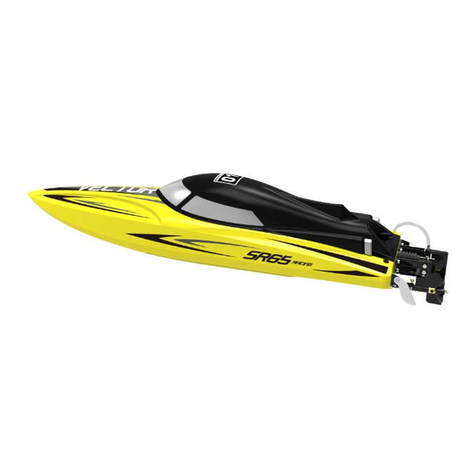Battery Safety Precautions!
!
IMPORTANT NOTE: Lithium Polymer (LiPo) batteries are significantly more volatile than the
alkaline, NiCd and NiMH batteries also used in RC applications. All instructions and warnings must
be followed exactly to prevent property damage and/ or personal injury as mishandling of LiPo
batteries can result in fire. By handling, charging or using the included LiPo battery you assume all
risks associated with LiPo batteries. If you do not agree with these conditions, please return your
complete product in new, unused condition to the place of purchase immediately. You must read
the following safety instructions and warnings before handling, charging or using the LiPo battery.!
!
•You must charge the LiPo battery in a safe area away from flammable materials.!
•Never charge the LiPo battery unattended at any time. When charging the battery you should
always remain in constant observation to monitor the charging process and react immediately to
any potential problems that may occur.!
•After discharging the battery you must allow it to cool to ambient / room temperature before
recharging. Also, it is NOT necessary or recommended to discharge the battery ‘completely’
before charging ( LiPo batteries have no ‘memory’ and it’s safe to charge partially discharged
batteries when using an appropriate charger and settings).!
•To charge the battery you must use only the stock included Charger or a suitably compatible LiPo
battery charger. Failure to do so may result in a fire causing property damage and/ or personal
injury. DO NOT use a NiCd or NiMH charger to charge Li-Po battery.!
•If at any time during the charge or discharge process the battery begins to balloon or swell,
discontinue charging or discharging immediately. Quickly and safely disconnect the battery then
place it in a safe , open area away from flammable materials to observe it for at least 15 minutes.
Continuing to charge or discharge a battery that has begun to balloon or swell can result in a fire.
A battery that has ballooned or swollen even a small amount must be removed from service
completely.!
•Never discharge a Li-Po battery below 3V per cell.!
•Always disconnect a battery from the ESC when not in use.!
•Avoid continually operating to LVC ( Low Volt Cutoff), as this could result in damage to the
battery.!
•Store the battery partially charged (approximately 50% charged/3.85V per cell), at room
temperature (approximately 68–77° Fahrenheit [F] ) and in a dry area for best results.!
•When transporting or temporarily storing the battery, the temperature range should be from
approximately 40–100°F. Do not store the battery or model in a hot storage car or direct sunlight
whenever possible. If stored in a hot garage or car the battery can be damaged or even catch
fire.!
•Do not over-discharge the LiPo flight battery. Discharging the LiPo flight battery to a voltage that
is too low can cause damage to the battery resulting in reduced power, flight duration or failure of
the battery entirely.!
•LiPo cells should not be discharged to below 3.0V each under load. In the case of the 2-Cell/ 2S
7.4V LiPo battery used to power the plane you will not want to allow the battery to fall below 6.0V
during flight.!
The included ESC features a ‘soft’ low voltage cutoff ( LVC ) that smoothly reduces power to the
motor (regardless of the power level you have set with the throttle stick) to let you know the voltage
of the battery is close to the 6.0V minimum.!




























